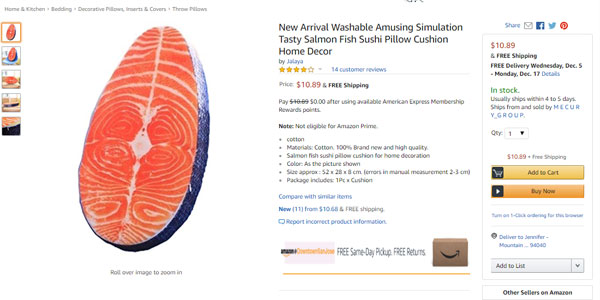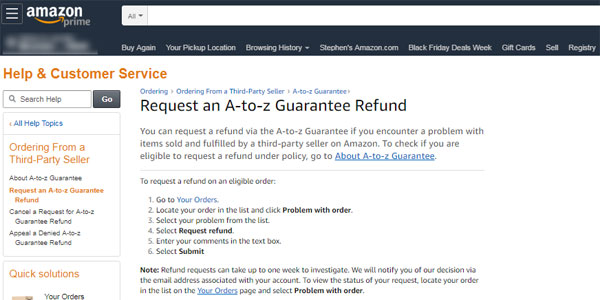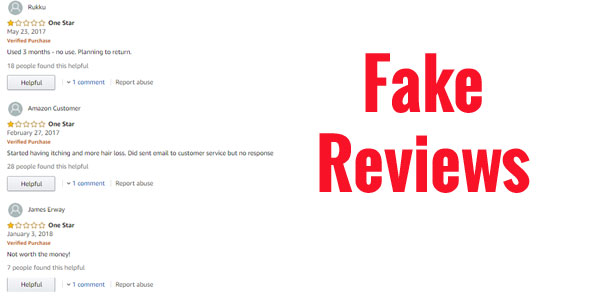Over the years, I’ve become increasingly disgusted with the multitude of Amazon scams that plague the Amazon marketplace. Everyday, honest merchants are getting ripped off by unscrupulous buyers and sabotaged by dirty sellers.
What’s especially frustrating is that Amazon never takes corrective action unless they receive enough negative press coverage.
Because Amazon is so powerful, they don’t care if any individual seller goes out of business because there’s always another seller in line willing to take their place.
And no matter what happens, Amazon still makes money!
It is also a well known fact that Amazon mostly favors the buyer in any dispute which makes the Amazon marketplace a prime target for fraud at the seller’s expense.
As a result, if you are selling on Amazon, you need to be aware of all of the Amazon scams out there to prevent yourself from getting ripped off.
This post is a compilation of Amazon scams that malicious buyers and sellers are currently using to rip you off.
Many of these scams target new sellers who haven’t registered their brand. In addition, Amazon sellers who sell via merchant fulfilled are much more likely to experience fraud.
Are you interested in creating a strong, defensible brand for your products? If so, I put together a comprehensive package of resources that will help you launch your own online store from complete scratch. Be sure to grab it before you leave!
Amazon Scam #1 – The Ebay/Amazon Dropship Swindle
Have you ever bought something on Ebay and received your order in an Amazon branded box?
Right now, there are thousands of sellers trying to make a quick buck by selling Amazon products on EBay at inflated prices.
This practice is called Amazon Ebay dropshipping.
When an Ebay order is received, the dropshipper purchases the same product on Amazon, has it delivered to the Ebay customer and pockets the difference.
Now normally this practice doesn’t hurt the Amazon seller. In fact, dropshippers have been selling my Amazon products for years on Ebay and for the most part, I don’t care.
But recently, there have been a series of scams targeting this practice.
Here’s what’s happening.
Fraudulent dropship sellers are buying Amazon products, shipping them to Ebay customers and then filing bogus A-Z claims after the product is delivered.
Because Amazon always favors the buyer, the scammer not only gets refunded but he or she also gets to pocket the money from their Ebay sale.
Meanwhile, the poor Amazon seller loses out on both the Amazon FBA fee and the cost of the product.
In addition, the false claims against the product severely damage the seller’s reputation which can result in suspensions.
There’s also another form of dropshipping fraud making the rounds that involves stolen credit card numbers.
A malicious dropshipper will use a stolen credit card number to buy a product from Amazon to fulfill an EBay order. Even though the credit card owner eventually discovers the fraudulent charge, it’s often too late.
The order has been delivered, the dropshipper has pocketed the cash and the seller loses money on the product.
Unfortunately, there’s no easy way to combat these dropshipping scams since Amazon always favors the buyer and it can be a lengthy battle to get your money back even if you do eventually win.
Amazon Scam #2: The Address Forwarding Rip Off
The address forwarding scam primarily targets merchant fulfilled Amazon sellers and takes advantage of Amazon’s lenient buyer policies.
Here’s how it works.
When you elect to fulfill an Amazon order yourself (via merchant fulfilled), Amazon requires that you must ship to the address provided by Amazon.
However a malicious Amazon buyer can purchase an item, wait until you’ve shipped it out and then contact you to request a change in address claiming that they have moved.
The customer will then complain and/or file a chargeback that the item was never received and Amazon will issue a refund.
If you elect to divert the package to the updated address, you are technically violating Amazon’s policies and have no recourse when the customer complains either.
It’s a catch-22 and the scammer wins either way.
Amazon Scam #3: The Inventory Tie Up Ploy
Unfortunately, I’ve been a victim of this scam several times in the past and there’s no real way to avoid it.
A malicious seller will use real or stolen credit cards to buy up all of your FBA inventory just before the holiday season begins.
And because you are out of stock, you have no product to sell during the busiest time of year.
Meanwhile, the malicious seller lists their competing products (sometimes on your own listing) and rakes in the sales.
Then once the holiday season ends, the evil seller returns all of your merchandise and gets a full refund.
Sometimes the malicious seller will use stolen credit cards to buy you out but the outcome is always the same. Either way, you’re out of stock and your inventory is tied up for at least 30 days or more.
The only real way to combat this scam is to set quantity limits on the number units sold per transaction on your listing but this can negatively impact legitimate sales.
Amazon Scam #4: Product Listing Sabotage
If you’ve sold on Amazon long enough, you’ve probably had Amazon change your listing titles and bullet points without your knowledge. And often times, Amazon will not let you alter their changes.
As a result, scammers have been intentionally influencing Amazon to make listing changes by providing false product claims.
Here’s how the ploy works.
An evil seller with multiple Amazon accounts will buy products and deliberately file complaints about inaccurate product descriptions.
For example, let’s say you sell 5 foot long white boards on Amazon. If Amazon receives enough complaints claiming that your 5 foot white board is really only 3 feet wide, they’ll sometimes change the listing to 3 feet and override your measurements.
Now you’d think that it’d be easy to prove that your white boards are really 5 feet long, but once a listing has been changed, it’s hard to change back.
Amazon will often give you the runaround and you’ll waste a ton of time trying to get your listing back to normal.
Meanwhile, your account is getting dinged with negative reviews and you’re getting a rash of returns because of the listing inaccuracies.
Amazon Scam #5: Fraudulent Claims Of Hazardous Materials, Counterfeit And Not Sold As New
It is surprisingly easy to get an Amazon listing suspended.
Because Amazon adopts a guilty until proven innocent attitude, all it takes are a few false complaints to completely ruin your account.
Here are some ways that malicious sellers are sabotaging good honest merchants.
If you are selling a product that contains chemicals or cleaning reagents, evil sellers can buy your product and claim that it contains hazardous or illegal materials.
Because Amazon always errs on the side of caution, they will almost always suspend your product for further investigation. And the reinstatement process can takes weeks or months.
Another quick way to get someone suspended is to file an inauthenticity claim against a product. Even if the claims are baseless, you’ll find that Amazon requires little or no evidence before taking action.
Another common way to get someone suspended is to purchase a competitor’s product and complain that their product is used or dirty.
If you don’t have tamper seals or an obvious way to tell that your product is brand new, you are susceptible to this form of sabotage.
Note: Amazon often puts returned merchandise back on the shelf if they deem that it is re-sellable and you can’t prevent this from happening as far as I know.
The only way to combat this form of sabotage is to have a seal on your packaging that is permanently broken when opened as this will prevent Amazon employees from putting used items back on the shelf.
Amazon Scam #6: Merchant Fulfilled Delivered Package Fraud
This scam only affects merchant fulfilled Amazon sellers and here’s how it works.
A buyer purchases a product on Amazon but requests that the shipping carrier (UPS, FedEx etc) hold the package for pick up instead of having it delivered.
But the buyer never picks up the package and instead files an A-Z claim saying that they never received the product.
Because the order was never physically delivered, Amazon provides a full refund because the seller can’t provide proof of delivery.
Meanwhile, the shipping carrier will not re-attempt delivery because of the instructions given by the recipient.
Once the refund is issued, the customer picks up the product from the shipping carrier and the seller loses money.
Amazon Scam #7: Amazon Sponsored Product Ads Click Fraud
If you find that your Amazon PPC ad budget is abnormally depleted early in the day, you could be a victim of Amazon Sponsored Product Ads click fraud.
Unfortunately, there are services out there that deploy special bots designed to click on your ads and artificially waste your ad budget.
Even though Amazon has security measures in place to combat fraud, it is impossible for Amazon to completely stop this malicious practice.
And what’s particularly frustrating is that it’s difficult to gather evidence to prove click fraud because Amazon controls everything.
There is no way to trace the origin of an ad click and Amazon can simply sweep the click fraud under the rug.
These false clicks not only cost you money but they also reduce your conversion rate which negatively impacts your keyword rankings.
Amazon Scam #8: The Bogus Return Swindle
This next case of fraud is another artifact of Amazon’s lenient return and “customer is always right” policy.
In this scam, a customer purchases multiple units of your product in separate transactions to different addresses.
Once the items are delivered, the customer then issues a return authorization for all of the units.
However instead of sending everything back, they only return 1 unit and claim that they placed all of the returned products in the same box.
Because there’s tracking on the return package, Amazon favors the buyer even though they didn’t return all of the merchandise.
As a result, Amazon refunds the buyer the full amount and you never receive your goods back.
Now you can try to fight Amazon by claiming that the weight of the packages don’t match but you’ll probably lose and waste hours of your time in the process.
Amazon Scam #9 – Phishing For Account Info
A phishing scam is where a scammer sends a fake email posing as Amazon and attempts to steal your information by directing you to a site that looks exactly like Amazon.com.
Here’s an example of a phishing scam that has been making the rounds.
From: seller-performance@amazon.com seller-performance-XXXXXXXXXXXXXX@mx1-amazon.com
Subject: Action Required: Your Seller Account FundsHello,
To protect you and the funds in your account, your account was flagged for further review.Funds will not be transferred to you but will stay in your account while we work with you to address this issue.
To remove the hold on funds, complete the following steps within 3 days:Reply to this message and provide the last 4 digits of your bank account on file with Amazon.com.
Once you respond, we’ll send you a separate e-mail with a personalized link to complete the review.
Once your account has been updated and verified, payment will be initiated on your next settlement date. Additionally, any fees owed for this settlement period will be charged to the credit card on your next settlement date.
We appreciate your help verifying your account as quickly as possible.
Regards,
Seller Performance Team
When you click on the link, you are directed to a site where the scammer will ask you for your Amazon credentials and credit card/banking information.
Now most of these phishing scams have been circumvented by Amazon through 2 factor authentication.
However, there’s an new phishing scam going around involving Amazon’s Transparency program.
Here’s what the scam looks like.
I would like to set up a call with you to discuss an opportunity to participate in Transparency, a new program from Amazon that helps you prevent the sale and shipment of counterfeit products to customers on Amazon.
For a limited time, we are offering Transparency free for the first 6 months. If you are interested in learning more, please fill out the contact form by clicking here and we can set up a time to discuss in more detail.
We look forward to hearing from you.
Regards,
Brand Registry Team
Once you schedule the call, the scammer then tries to grab your Amazon login credentials and the 2 factor authentication code from your phone. They may also ask for your credit card number or banking information.
If you give them this information, they will then proceed to lock you out of your Amazon account.
Amazon Scam #10: Fake Review Sabotage
I’ve been selling on Amazon for over 5 years and there’s still a big time fake review problem.
Without even trying, you can easily find companies in China offering fake negative review services where you can instantly sabotage a competitor’s listing for a small sum of money. It’s not even that expensive!
Here’s how it works.
A malicious seller pays a service to leave negative reviews on your brand new listing. The service then uses hundreds of fake Amazon accounts to buy your merchandise and have it sent to random people.
Then, they leave fake negative reviews which are “verified” and destroy your sales.
This same tactic can be used to file false A-Z claims of counterfeit merchandise, item not as described or items sold as used as well.
What sucks is that you can’t really do anything about it and Amazon will rarely remove a review from your listing.
The Scammers Keep Getting Smarter
Despite Amazon’s best efforts to combat fraud, scammers are getting more and more sophisticated everyday. Because Amazon is such a cut throat marketplace, you are almost guaranteed to be attacked by malicious sellers at some point in your Amazon selling career.
Even though Amazon has been fighting back with programs like Amazon Transparency, most of Amazon’s new fraud programs require brand registry.
As a result, it’s in your best interests to register your trademark and your brand ASAP to take advantage of the added protection.
It also helps to sell your products via FBA instead of merchant fulfilled to avoid getting scammed by unscrupulous buyers who make false shipping claims.
Overall, Amazon is a great place to make money but it often comes at the expense of your sanity. If you don’t enjoy living your life in constant fear of suspension, you should consider diversifying your income and selling on a platform that you control.
Selling on your own website not only offers you peace of mind but you are also building up a foundation for repeat sales as well. Good luck!

Ready To Get Serious About Starting An Online Business?
If you are really considering starting your own online business, then you have to check out my free mini course on How To Create A Niche Online Store In 5 Easy Steps.
In this 6 day mini course, I reveal the steps that my wife and I took to earn 100 thousand dollars in the span of just a year. Best of all, it's free and you'll receive weekly ecommerce tips and strategies!
Related Posts In Fighting Dirty Amazon Sellers
- The Dangers Of Selling On Amazon And Horror Stories From Real Amazon Sellers
- How To Report A Seller On Amazon And Fight Hijackers Who Steal Or Piggyback On Your Listing
- Why Amazon Sucks For Building A Sustainable Ecommerce Business
- Amazon Suspension Appeal: How To Get Your Amazon Account Reinstated
- 5 Reasons Amazon Sellers Need To Start Their Own Ecommerce Store

Steve Chou is a highly recognized influencer in the ecommerce space and has taught thousands of students how to effectively sell physical products online over at ProfitableOnlineStore.com.
His blog, MyWifeQuitHerJob.com, has been featured in Forbes, Inc, The New York Times, Entrepreneur and MSNBC.
He's also a contributing author for BigCommerce, Klaviyo, ManyChat, Printful, Privy, CXL, Ecommerce Fuel, GlockApps, Privy, Social Media Examiner, Web Designer Depot, Sumo and other leading business publications.
In addition, he runs a popular ecommerce podcast, My Wife Quit Her Job, which is a top 25 marketing show on all of Apple Podcasts.
To stay up to date with all of the latest ecommerce trends, Steve runs a 7 figure ecommerce store, BumblebeeLinens.com, with his wife and puts on an annual ecommerce conference called The Sellers Summit.
Steve carries both a bachelors and a masters degree in electrical engineering from Stanford University. Despite majoring in electrical engineering, he spent a good portion of his graduate education studying entrepreneurship and the mechanics of running small businesses.





















Good summary.
You can call it either cutthroat or ridiculous.
We’ve had items purposely left out of product. Customer keeps one part they want and returns the other for full refund.
Also have people who have never purchased from us message us saying they never received it OR they want a replacement.
Things get worse, where they buy off Amazon, come back to our website 9 months later and then request a replacement.
Amazon clearly encourages and supports all types of customer fraud. A seller doesn’t have a chance with all of the bogus claims. Amazon associates will not only flat out lie. but will defend customers even if the seller has solid proof of the fraud. Amazon is obviously just as fraudulent as the dishonest customers they side with. Why are they not held accountable?
When a buyer steals an item by filing a bogus claim and resells it on Amazon, Amazon gets to charge its inflated fees twice for the same item. Of course they encourage fraud: it is profitable. They will only stop doing it if an outside agency holds them accountable.
And this is why I DO NOT sell on amazon! Only on my website
I may have been a victim of Product Listing Sabotage.
Does Amazon tell you if there has been product listing complaints?
I’m done with amazon, of 200 books I sell on amazon, the fees for one and the customer is always right bull shit. they read the book and say oh I ordered by mistake happens 1 out of 3 times lately. I’m not talking 5$ books I’m talking $75 dollar books and just becuase the don’t like the content they can return it for not liking the author. I have to come up with the money. and I’m a small time seller just trying to make a few bucks, not happening. amazon really sucks when you really think about it. the seller has no chance of being treatly fairly. why do it if your just losing money. I’m done
I called amazon to tell them about a seller who stole images from Etsy to sell as their own for a very low price, shipped from China. I gave them the names, and the stollen images but they did not care. I was told someone will call me but no one did. So the next best thing was to write a review on these items that they are stollen images. Well guess what amazon did not add them, they deleted all reviews that made them look bad.
I will never buy amazon again, I sent articles to my family and they will not buy amazon again.
Just saw a book on Amazon with two sellers listing it for 9.99 and one seller listing it for 899.99 dollars. I guess they were hoping some poor old granny would hit the wrong button. Shame on you Amazon!